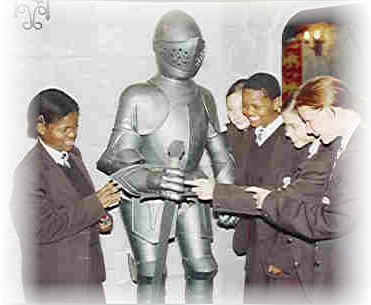HERALDRY
What is Heraldry?
The need
for heraldry arose in the early Middle Ages as a means of identification.
The knights all looked alike in their suits of armour, so they needed some way
of telling friend from foe. To overcome this problem, the knights created
designs unique to each noble family. An official body, the College
of Heraldry recorded each design.
This
College also trained Heralds. These were the people who had to learn all
the Coats of Arms and be able to identify them. The Heralds were
used in battles, informing the knights of the approaching armies. They
were also present at jousting contests, acting as master of ceremonies, by
announcing all the participants who would otherwise be unrecognisable, as
they were fully incased in their suits of armour.
To
be able to verbally describe a visual object like a Coat of Arms, a whole new
language was developed. The actual description is called 'Blazon'.
The vocabulary was taken from the Anglo-French. For example, to describe a
white lion, one says Leon Blanc.
TERMS OF HERALDRY
To understand heraldry, its special terms or language have to be studied. For instance, a complete display of arms, crest and other accessories is called an "achievement". An achievement may be granted to individuals as well as societies or corporations. In compiling a heraldic crest, certain rules have to be followed.
An achievement may contain some of all of the following:
Shield - the most important part which carries the "charges" that distinguishes one coat of arms from another. It can be used just by itself
Helmet - appears above the shield and its type and position reflects the status of its owner
Mantling - likened to the mantle worn by knights, it envelopes the top of the helmet and drapes down both sides of the shield
Wreath - a twisted silk piece covering the joint of the helmet
Crest - an object worn on the helmets of knights, usually during jousts. It is often incorrectly used when referring to a coat of arms
Supporters - animal or human figurines sometimes used to hold up the shield
Coronets - these circlets are found in achievements of noblemen (dukes, earls, marquesses, viscounts or barons) and the rank defined its pattern
Motto - is usually displayed on a scroll placed either over the crest or at the base beneath the shield.
COLOURS OF HERALDRY
It is important to understand the colouring associated with heraldry:
Tincture - is used to describe either metal or a colour
Metals - Or (gold) Argent (silver)
Colours - Gules (red) Azure (blue) Sable (black) Vert (green) Purpure (purple)
Furs - Ermine (black spots on white, representing tails, Ermines (white spots on black), and vair (blue and silver representing grey squirrel skins). These are the most common of the furs.
To illustrate the use of some of these terms, refer to the official description of the Blazon of the new South African Coat of Arms
To design your own Coat of Arms go here